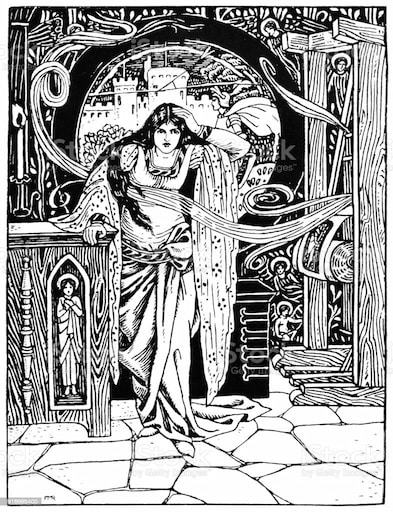Love at First Sight in “The Lady of Shalott”: Sexual Desires and Loneliness
by Maggie Martone
We’ve all seen love at first sight portrayed in differing forms of media such as movies and books throughout our lives. But where did this ideal originally come from? Well, it seems to first appear in Greek and Roman literature with Cupid and his arrows, as he leaves his victims in a helpless state of erotic love for whomever they first see. This somewhat negative perception of the ideal continued into Medieval romance as many of the most popular works of this period associate love at first sight with an unstoppable romantic love driven by physical attraction. Within Alfred Tennyson’s ballad “The Lady of Shalott” we see how certain mentalities make one susceptible to this detrimental love as it is the reason for the title character’s demise. She cannot help but to break the rules of her curse and die because of it.
The lady is not aware of what the consequence of breaking the curse is, though she knows that she is not supposed to look at Camelot unless it is through a mirror. Yet when she sees the character of Sir Lancelot in all his glory, she immediately runs to look directly at him, overcome with love. But this love is Eros love, as it is sexually driven and far from innocent. The lady does not personally know Lancelot, she is drawn to him purely because of his physical attractiveness. The severity of the curse emphasizes the intense burden and shame women feel for the suppression of their sexual desires as men of the time greatly disapproved of any revelation of them. Yet the lady makes this life-altering decision hastily as “She left the web, she left the loom, / She made three paces thro’ the room, / She saw the water-lily bloom, / She saw the helmet and the plume, / She look’d down to Camelot” (3.109-113). Here her body acts before she can think, thus demonstrating how her sexual desires overtake her common sense. The intensity of sexual temptation causes her to run past everything she has ever known to satisfy these new desires.
The Lady’s lonely mentality also does her in as she expresses an emotional need for romantic love in her life even before Lancelot’s first appearance. Prior to this disclosure, she expresses her contentment with her solitary life, but lonely thoughts set in, and she becomes weak and desperate, becoming more susceptible to sexual desires and the curse. The first instance in which she demonstrates her longing for a partner is when the ballad says, “Or when the moon was overhead, / Came two young lovers lately wed; / ‘I am half sick of shadows,’ said / The Lady of Shalott” (2.69-72). This tells of her experience catching sight of a romantic couple which elicits her feelings of loneliness and desire. We soon learn that this is the beginning of her downfall and eventual death. The severity of this outcome likely demonstrates the pertinence of women’s sexuality and the loneliness that comes with maintaining men’s ideals of hidden emotions and virginity in Medieval times.
Overall, we see the weakness and vulnerability that comes with love at first sight through Alfred Tennyson’s “The Lady of Shalott” as the title character’s lack of sexual fulfillment and the loneliness she feels makes her susceptible to Eros and thus her eventual death. This demonstrates the negative aspects of Medieval society that pressure women to keep these feelings to themselves until they eventually reach their limit and face their doom.






